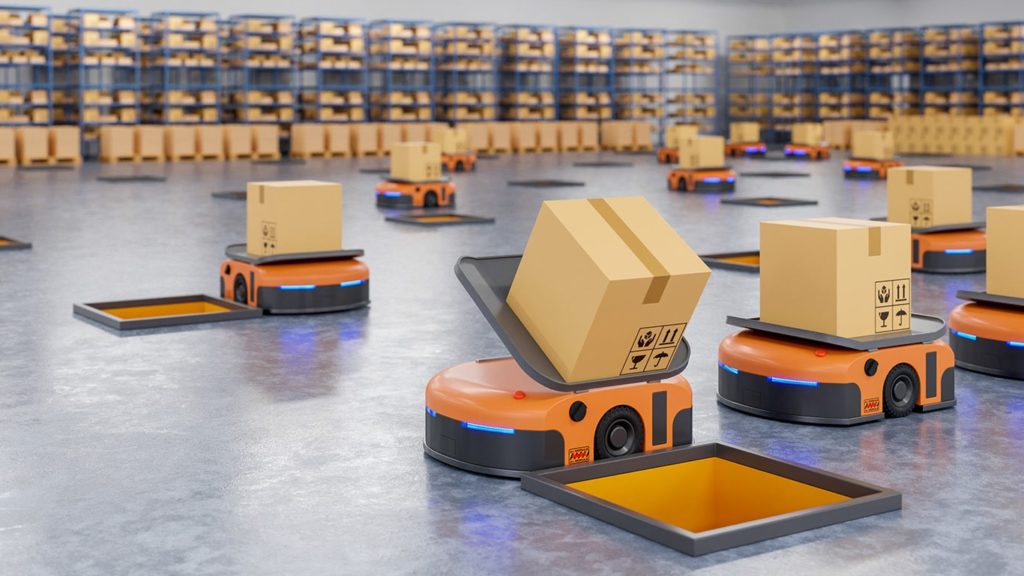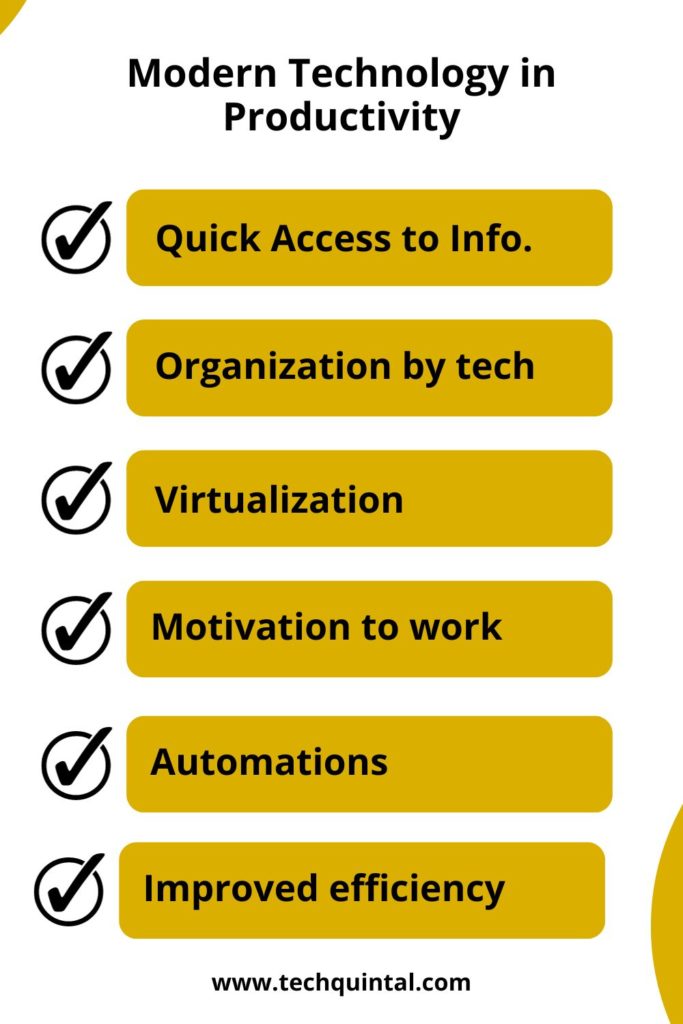
It doesn’t matter if you are just a student trying to get good grades while keeping up on some extracurricular activities or a businessman looking to step up their game, doing work & other related activities efficiently helps reduce the time it takes to accomplish them. Thereby clearing up some time for you to relax & rest. Increasing your productivity means cutting out the things/tasks that drain your energy or time by either redirecting them to others or better yet, to technology. Using technology in workspaces has tremendously reduced many time-consuming & redundant steps in completing our tasks.
What is the role of technology in improving productivity?
Technology plays an important role in improving productivity across various sectors. It not only helps with industrial production but also with workplace productivity. By using automation, project management, or even AI, technology has made employees more efficient.
In fact, 92% of the workers, when surveyed, said that technology was responsible for making their jobs easier, which in turn impacted their happiness levels and job satisfaction and ultimately led to an increase in productivity. Wearables such as smartwatches have also made a decent contribution, as the number shows, they have increased productivity by almost 9% and job satisfaction by 3.5%.
But is technology only useful for improving productivity? To find out more about the benefits of technology in the workplace, watch the following video:
Upcoming trends and the future of technology in workplaces
Technology is ever-changing and evolving. Even when it comes to our workplaces, we are more than likely to experience this shift. Below are a few predictions about what the future might hold when it comes to technology in workplaces:
Emergence of a more sophisticated hybrid workspace
Although we have started working from home and remote working has been on a steady rise, many experts believe that it is only the surface of what we might soon achieve. Technology is set to revolutionize remote working, creating a hybrid workplace by using virtual or augmented reality, AI, and other remote working solutions.
Embracing automation
Next up is automation, which we already have in our workplaces, but on a larger scale. All this is possible due to the advent of AI in recent years and how the world has shifted towards the growth of AI technology. Many companies are banking on utilizing this newest tech in order to remain ahead of the curve. Thus, AI-powered automation is the future of workplaces.
Metaverse as the next meeting room
Yes, many are hopeful about the rise of VR and AR tech and how it can be used in collaborative projects. Metaverse can provide them with a platform where virtual meetings can take place. It is the next step in remote working. Furthermore, it can also be used for training and mentoring purposes, making employee integration much easier.

Quantifying employee experience and an analytical approach
The technological advancement will also allow the company to better take care of the employees, ensuring job satisfaction and making workplace improvements that can actually be measured. Thus, by analyzing the contributing factors, they can even quantify the level of experience an employee gains and how it reflects on the work environment.
No more rigid roles
Finally, the technological revolution will do away with static job roles and processes as it can allow employees to perform above and beyond the scope of the job. Flexibility in roles can also highlight employees’ contributions more easily and create a workplace environment where they can thrive and become more efficient.
How does Technology Improve Productivity?

Technology improves productivity by streamlining processes, reducing manual tasks, and speeding up communication. For example, automation tools can perform repetitive tasks quicker and with greater accuracy than humans. Here are some ways in which modern technology increases our productivity:
1. Quicky accessibility to information & effective communication
An abundance of information about any particular topic is easily accessible on the internet. Today people can learn any skill they would like to know about, on YouTube, Skillshare, or other such learning platforms. Sharing of information is crucial in a work office environment.
The employees work on their tasks which are then, contributed together to keep the company flourishing. This efficient availability of exchange of precious data has given rise to the connection of dispersed workforces.
Without the technology of the internet, we would have a really difficult time exchanging information. Collaborations over long distances would be impossible if not impractical considering the time it would take to exchange data.
2. Organization by tech
Imagine looking for a file in a basement full of folders containing documents, now this nightmare is fortunately not a reality anymore. Organization of data has vasty become efficient & easy thanks to modern technology.
Finding a single word from thousands of documents is effortless by using the search feature in most organizing software. Tracking the progress of your work or habit is simplified thanks to automation by just a few codes. Virtualizing & uploading old files not only clears out physical space for other important things but also makes it way easier to look for a particular file from the whole stack.
3. Virtualization
Virtualization not only provides ease in looking up things it also increases the lifespan of computers greatly. Storing large amounts of data on your hardware draws a lot of power from your CPU. This high power consumption in turn increases hardware maintenance costs.
By uploading the bulk of your data you reduce the power usage of your computer thus reducing the frequency of replacing or upgrading your devices. Taking a step further to add more feasibility, installing the same cloud system on your phone saves you time while accessing documents & other data as you might not have your PC all the time.
4. Easy accessibility to experts
Instead of being a jack of all trades at work by doing everything yourself, it’s quite better to assign tasks to subject matter experts. Experts in any field are just a click away, thanks to the internet. Any service can be outsourced, it need not be a professional job.
Even physically demanding tasks such as the delivery of goods can be contracted to delivery services. Doing this allows you to completely focus on your tasks & field of expertise. Another positive outcome of the availability of exerts online is that with a high number of suppliers (experts), the cost of the service is relatively reduced due to increased competition.
5. Technology motivates us to work
Everyone struggles with low motivation once in a while. This could be solved by activities like yoga or exercise, but if the way we do work is inefficient, we are bound to get unmotivated more often. It might be the case that an old device is interrupting your workflow.
A remedy for this particular problem would be to upgrade your workstation (PC or any work device) so that it performs better. Ben Parker’s well-said words “With great power comes great responsibility” are perfectly applicable here as well. A fast connection & a powerful device will motivate you to complete your work quickly. Upgrading your device’s hardware or software will produce some great results as well.
6. Automating customer service
One of the biggest contributions of modern technology is automating mindless small tasks. But in recent years due to the advancement in technology customer services have been automated by chatbots.
Customer service is an integral part of any company, a good service helps customers trust the company & in turn increases the sale of the products. But customer service can be a real pain for new companies as they lack the huge manpower it requires.
Chatbots can vastly reduce the amount of manpower required for successful customer service. This not only cuts down the cost of delivering this service but also saves time which can be better spent on other meaningful tasks.
7. Focused marketing
A few decades ago finding the right audience for a particular product was quite troublesome. From booking & placing ads on billboards or placing newspaper ads, these marketing tactics were the only factors companies could rely on during those days.
Today the companies of the world have access to “personalized marketing”, this method utilizes advertising each individual according to their preferences. Ads on Instagram & Facebook are highly inspired by what you browse on your phones, thus the accuracy that an advertisement for any particular product reaches its target audience.
Similarly, social media influencers promote products & services that will correspond with huge sales of those products/services. Today the effort & money required to broadcast a product are quite minimal as compared to a decade ago.
8. Higher Efficiency
Technology has allowed employees to become more efficient by freeing up extra time that can be dedicated to other necessary processes. Thus, they can focus more on business-related issues rather than getting tangled up in administrative tasks.
The liberal use of chatbots across various industries is a testament to this sentiment, as they have removed the human factor from the task of directing customers to relevant personnel or departments.
The effect is not just in the office or workplace, but also in other important areas such as agriculture. We have an article covered on the topic of how modern technology helps agricultural productivity.
9. Better Project Management
With the help of project management tools, it has become easier for the administration to divide and assign tasks suited to particular employees. Using the software, managers can much more easily assign tasks and track their progress. File sharing has also been simplified, and such tools have provided a convenient platform where many can come together for a collaboration project. It also allows the team members to be clear about their responsibilities and what is expected of them.
What are the different technologies that have helped increase productivity?
Here are some of the technologies that are prominent in workplaces to help increase productivity:
| Technology | Impact |
|---|---|
| Automation | Reduces manual labour |
| Cloud Computing | Helps with remote working, increases collaboration, and saves hardware costs |
| Project Management | Better collaboration |
| AI | Enhances decision-making and saves time by taking over repetitive tasks. |
| Remote Working | Remote working enhances job satisfaction and increases productivity |
| Data Analytics | Process optimization and better control by providing insight into decision-making. |
| IoT devices | Helps with monitoring and control |
| Communication Tools | Video calling or conferencing tools that can facilitate real-time collaboration |
Conclusion
Improving your productivity day by day & having a solid plan is the road to success. Everyone can use today’s technology to work efficiently, a student may learn better learning techniques like spaced repetition & active learning on the internet or a CEO of a company may find more time in his daily life by automating tasks like buying groceries, a chef, automating personal bills, etc. Doing work faster provides us more time & energy to do more deserving tasks or get some rest to avoid burnout.